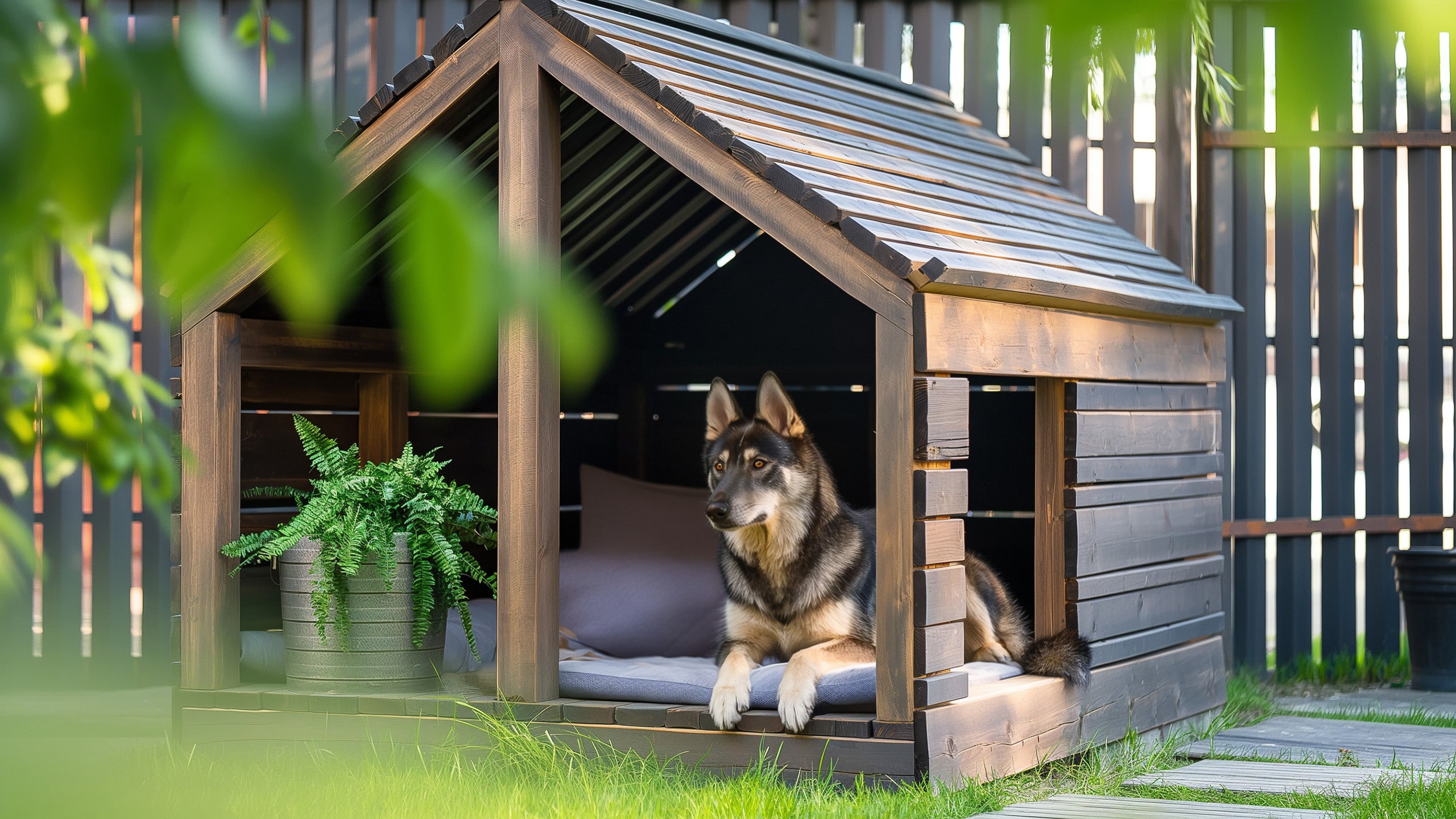Navigating the challenges of a dog-friendly yard can be simple with the right strategies. Our guide to dog-proof landscaping ideas provides several methods to create a low-maintenance, attractive outdoor space that accommodates both your landscaping aspirations and your dog’s well-being.
Key Takeaways
Design your garden with non-toxic plants and robust structures to keep it looking great and safe for your pup. Introduce dog-friendly ground covers and paths to direct their play and minimize damage.
Consider using artificial grass for a low-maintenance, always-green yard, or create specific dog play zones with soft bedding and water features to keep your pooch cool and entertained.
Incorporate durable and easy-to-clean materials in high-traffic areas, like concrete or paving stones, and use strategic fencing to allow dogs to roam freely without harming sensitive areas like vegetable gardens and flower beds.
Table of Contents
Creating a Dog-Proof Backyard Oasis
It may seem challenging to create a dog-proof backyard oasis, but it can be as simple as integrating robust plants, installing appropriate fencing, and using dog-friendly ground covers. These measures help create a space that caters to your pup’s natural behaviors and enhances the overall visual appeal of your yard.
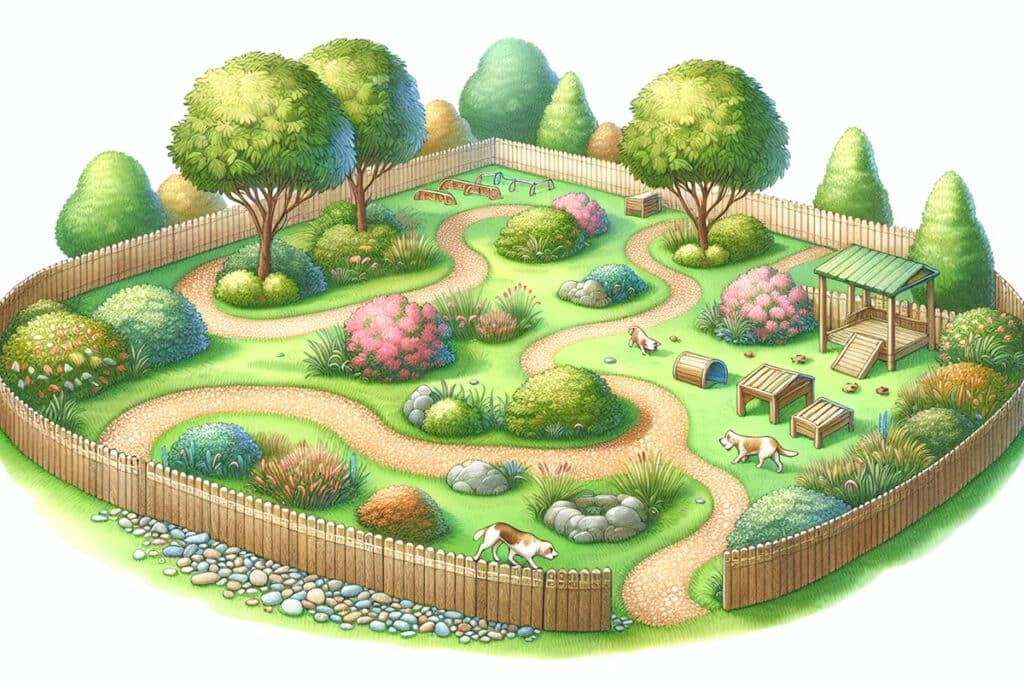
Selecting Non-Toxic Plants for Your Pup’s Safety
Dog safety is a critical factor to consider when setting up a garden. Given dogs’ natural tendency to chew on objects they encounter, selecting non-toxic plants is imperative. A garden filled with safe plants like:
catnip
marigolds
rosemary
sage
not only ensure your dog’s safety but also repel fleas, enhancing your yard’s ecosystem. And when it comes to mulch, avoid cocoa bean shells, which can be toxic to your pup.
You may also be interested in the article we did about pet-safe plants for inside the house as well.
Utilizing Hardscape Elements to Minimize Damage
Hardscape elements like paving stones, gravel, and decorative rocks can form very durable areas in your yard, resistant to dog behaviors such as digging. Not only that, these elements handle the acidity of dog urine better than traditional lawns.
Gravel, especially in shaded yards, can act as a ground cover, staying cool for dogs even during warmer weather, all while minimizing lawn damage.
Designing With Dog Paths and Barriers
Dog paths and barriers can save your garden from unwanted damage. By creating a dog path using light-colored stones or pea gravel, you guide dogs through the garden without damaging plants or lawns. Plus, these materials are comfortable for your dog’s paws and don’t absorb excessive heat.
When combined with strategically placed barriers, these paths protect your lawn and flower bed areas from repeated trampling.
Ground Covers That Can Stand Up to Paws and Play
Choosing ground covers that can withstand play and are safe for pets is a key consideration. Durable options like tall fescue grass, clover, and Zoysia grass are not only capable of withstanding heavy dog activity but are also non-toxic, ensuring your dog’s safety while preserving the integrity of your garden.
We have more details about keeping a pet-safe lawn if you want to dive deeper.
Grass Alternatives That Save Your Green
If you’re looking for a low-maintenance alternative to natural lawns, consider artificial grass. Known as ‘Pet Turf’, it’s not only long-lasting but also requires little maintenance. Its natural-looking ground cover is beneficial for areas frequented by dogs and children, ensuring a green appearance without the typical lawn care, and can be a great alternative to buffalo grass.
A dog run with pet-friendly artificial turf localizes dog pee, preventing urine spots on other parts of the lawn and easing cleanup.
Creating Comfort Zones with Soft Bedding Areas
Soft bedding areas for your dogs will encourage some occasional downtime, which is important for pups playing outside in the sun. Bedding materials like cedar chips provide comfort and repel insects naturally. For high-traffic areas, affordable options like wood chips or mulch are great, but remember to choose types that don’t harbor pests like fleas or cause splinters. A natural bed of pine needs is also ideal.
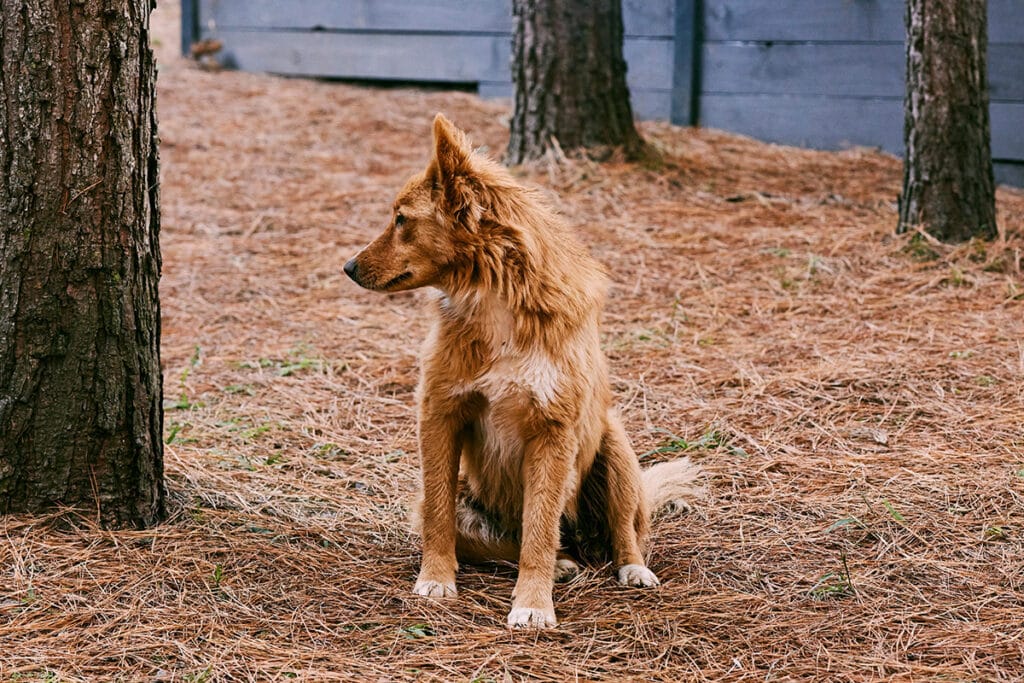
Adding sandbox areas to your yard is beneficial as it provides dogs with a designated place to dig, thereby preventing damage to other parts of the lawn or garden.
Water Features That Keep Dogs Cool and Hydrated
Especially during hot summer months, it’s crucial to keep your dogs cool and hydrated. Introducing features like:
a doggy splash pool
a hard plastic kiddie pool
DIY water features like sprinklers attached to a hose
dog pools
homemade drinking stations
can help your dogs cool down. These features provide hydration and cooling, adding a playful element to the yard.
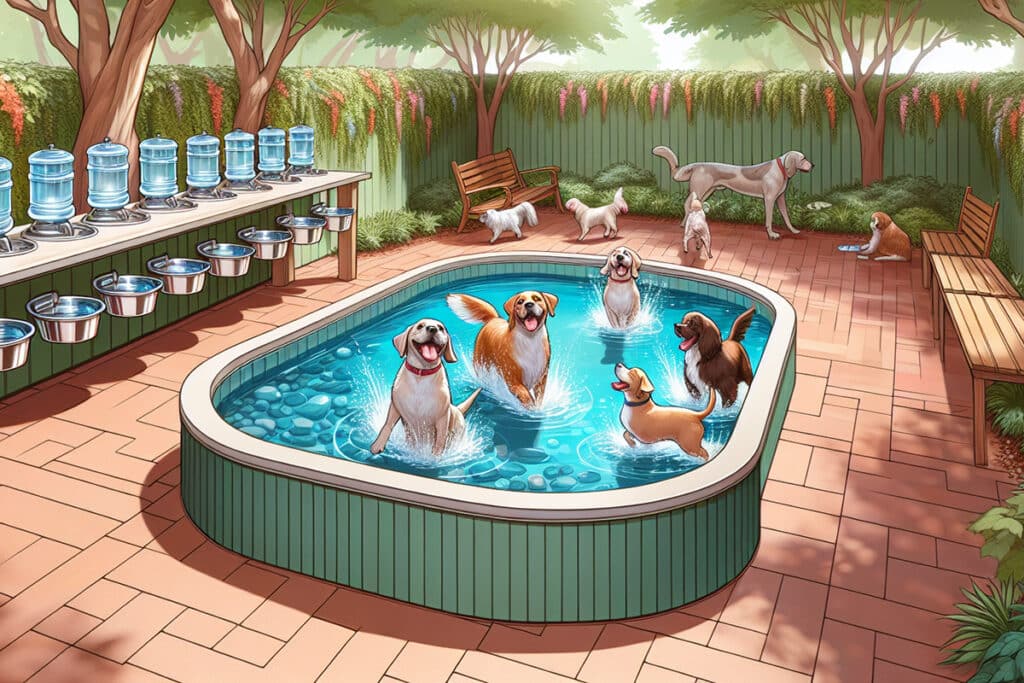
DIY Dog Pools and Ponds
DIY dog pools and ponds are a fun addition to any backyard. You can create a simple dog pool by digging a suitable hole and setting a hard plastic kiddie pool into it or go for something more advanced like a bone-shaped dog pool with a wooden deck.
Safe Drinking Stations for Thirsty Pups
Hydrating your dogs is equally important as keeping them cool. Setting up safe drinking stations for thirsty pups is a must. You can create a basic homemade doggy drinking station using a bottle and a few simple tools or go for an elaborate DIY drinking fountain with a bowl, a filter pump, and pebbles.
Fencing Solutions to Keep Your Dog Contained
Installing fencing is critical for your dog’s safety and to ensure they can freely roam without wandering off or getting into trouble. Vinyl fencing is a safe and low-maintenance option that is resistant to wear and provides a strong barrier suitable for dogs.
Dog-run fences or chicken wire fences are other alternatives to contain your dog within a specified area, but you need to make certain it will be durable enough if your dog jumps into it. “Supervising the neighbors” is common dog protocol, so expect any fencing to take its share of leaning and jumping.

Permanent Enclosures for Peace of Mind
Setting up permanent enclosures provides peace of mind to dog owners, especially during busy times or when away from home. By designating a specific area of the yard with a permanent enclosure, dogs are allowed to dig and play without damaging the garden. Not to mention, a permanent dog fence offers dog owners peace of mind, knowing their pet is secure at all times.
Temporary Fixes for Immediate Needs
Temporary fencing is an affordable way to manage your pets’ outdoor access. Portable playpens, freestanding fence panels, and expandable gates are easy to install and move, making them a quick fix for immediate fencing needs.
A temporary fence made from chicken wire can serve as an effective barrier to prevent dogs from entering areas with new grass until it’s ready for traffic.
Shady Retreats for Resting Pooches
In the hot summer months, providing shady spots for dogs to relax and cool down is crucial. This will help them stay comfortable and avoid overheating. Some ways to provide shade and shelter for your dog include:
Shady trees in the backyard
Awnings or canopies
Dog houses
Permanent structures like pergolas
These options can prevent your furry friend from overheating.
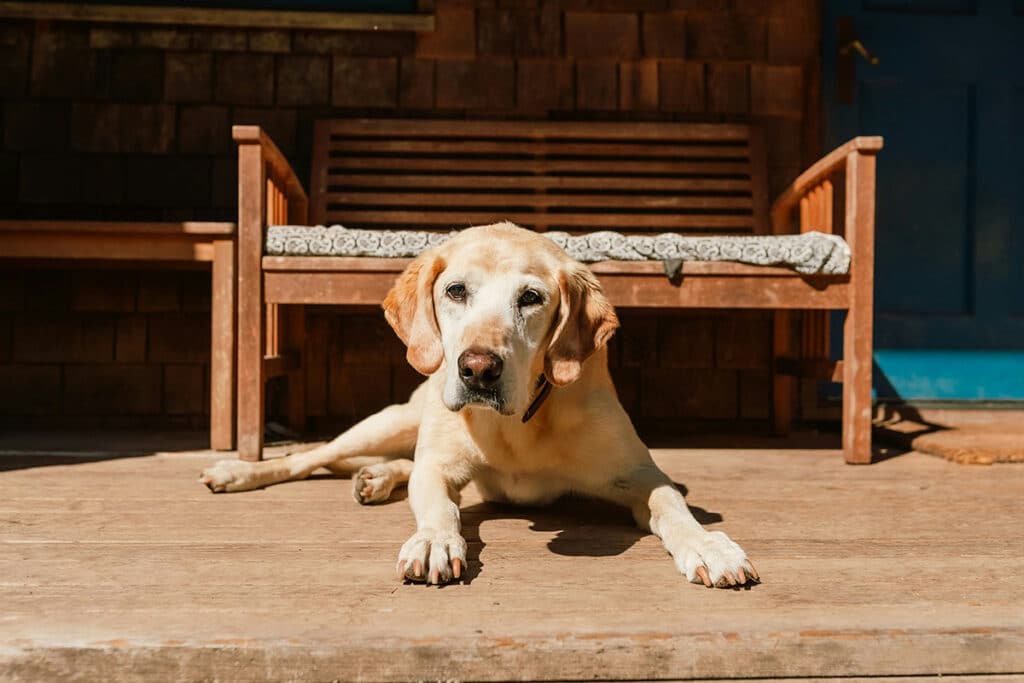
DIY Dog-Friendly Features for Active Canines
DIY dog-friendly features can serve as an engaging way to keep dogs entertained. A DIY agility course, for instance, can provide physical activity and mental stimulation, keeping your dog focused away from sensitive garden areas. However, safety is paramount when designing a DIY agility course. It’s recommended to seek veterinary advice to ensure a dog is physically capable of participating. There are so many ways to exercise your pup, and some can be done right in your backyard.
Crafting Homemade Toys and Obstacles
Crafting homemade toys and obstacles for your active dogs can be a fun and cost-effective way to keep them entertained. Old T-shirts, jeans, or towels can be converted into entertaining toys for dogs such as tug toys.
Agility jumps can be easily set up using flowerpots as the base and a PVC pipe as the bar. For a more permanent play fixture, a child’s play tunnel can be secured to the ground with tent pins, creating a fun obstacle for dogs. Facebook’s marketplace is a treasure trove of items, oftentimes freely available, that you can use for these purposes.
Setting Up a Training Space for Skill Building
A designated training area in your yard is key to focus your dog’s attention and minimize distractions during trick teaching and obedience training. Homemade agility equipment, such as PVC pipe jumps, can enhance a dog’s overall fitness.
Select a level space in your yard to set up the training area, and assemble the PVC pipe jumps for various training exercises.
Strategies to Protect Your Vegetable Gardens and Flower Beds
Dogs may find vegetable gardens and flower beds tempting spots to explore and dig. By erecting a garden fence, you can deter your dogs from damaging these areas. Constructing raised garden beds can also keep sensitive plants out of reach of dogs.
Natural deterrents like chili peppers and coffee grounds spread around the garden can also prevent dogs from digging.
The Art of Dog-Proofing High-Traffic Zones
Proactively dog-proofing high-traffic zones in your yard can prevent extensive damage and lessen maintenance. Using a combination of different ground covers in these areas can cater to various activities while ensuring durability and ease of maintenance.
Choosing Durable Materials for High-Impact Areas
It’s important to opt for durable materials when dealing with high-impact areas in your yard. Pathways and patios must be constructed from materials that can sustain heavy use from both dogs and their owners. Concrete, paving stones, and artificial grass are considered robust options for these zones.
These materials not only last longer but also offer ease of cleaning, making them practical choices for dog-friendly landscaping.
Implementing Effective Dog Run Surfaces
Implementing effective dog run surfaces for play areas is an essential part of creating a dog-friendly backyard. Surfacing such as turf, kennel tiles, and grass are recommended for high-traffic areas in dog runs due to their durability and ease of maintenance.
Loose-fill surfacing, which includes options like wood chips, gravel, and mulch, offers distinct advantages in terms of dog comfort and ease of maintenance.
Low Maintenance Landscaping That Meets Dog Owners’ Needs
Creating a dog-friendly backyard doesn’t have to consume all your free time for maintenance. By utilizing dog-friendly shrubs, perennials, grasses, and trees, you can reduce maintenance needs while ensuring pet safety. Some dog-friendly backyard ideas to consider for your backyard are:
Lavender
Sunflowers
Blueberries
Rosemary
Catnip
In addition to choosing the right plants, installing vinyl fencing can provide a strong, aesthetically pleasing barrier suitable for dog owners. Vinyl fencing requires little to no maintenance and is resistant to wear.
Establishing a specified area for dogs within the outdoor space can help concentrate dog-related wear and tear, reducing the impact on the overall dog-friendly yard for most dog owners.
Safe Alternatives to Traditional Lawns
A dog-friendly backyard doesn’t have to be solely about traditional lawns. There are plenty of safe and fun alternatives available. Artificial grass, also known as ‘Pet Turf’, is a popular choice due to its low-maintenance and pet/child safety ratings.

Another non-living ground cover option that provides a dog-friendly environment is pea gravel. Additionally, Irish moss, creeping thyme, and cedar chips are some natural ground cover plants that can act as sturdy, dog-friendly alternatives to traditional lawns.
Summary
Designing a dog-friendly backyard doesn’t have to be a daunting task. With a little creativity and the right knowledge, you can create a space that caters to your dog’s needs while maintaining an attractive backyard that’s the talk of the neighborhood. From crafting homemade toys and obstacles to setting up effective dog run surfaces, every detail counts in creating a perfect haven for your furry friend. So, are you ready to transform your backyard into a pooch-perfect yard?
Frequently Asked Questions
What are the best non-toxic plants for a dog-friendly backyard?
Plant catnip, marigolds, rosemary, and sage in your backyard to keep it dog-friendly and free of toxic plants.
What materials can be used for dog paths and barriers?
Consider using light-colored stones or pea gravel for your dog paths. They are comfortable for your dog’s paws and don’t absorb excessive heat.
What are some low-maintenance alternatives to natural lawns?
Consider using artificial grass, also known as ‘Pet Turf’, as a low-maintenance alternative to natural lawns. It resembles natural grass and is safe for pets and children.
How can I prevent my dog from damaging my vegetable garden and flower beds?
To prevent your dog from damaging your vegetable garden and flower beds, consider erecting a garden fence or constructing raised garden beds. Using natural deterrents like chili peppers and coffee grounds can also help keep dogs from digging.
What are some durable materials for high-traffic zones in my backyard?
For high-traffic zones in your backyard, consider using concrete, paving stones, or artificial grass as they are durable and can withstand heavy use.
